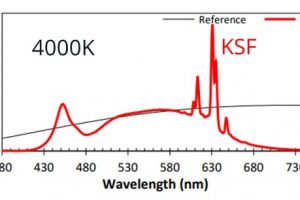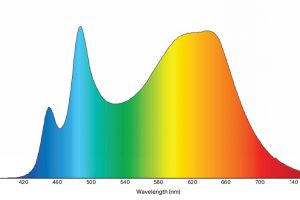Osram has teamed up with Infineon to add NFC set-up to led lighting to a non-dimmable Osram led driver family. “NFC programming is designed to replace resistor-setting techniques via a contactless NFC interface,” according to Infineon. “The integrated ‘constant lumen output’ functions additionally help saving energy by maintaining the luminous flux constant over an extended luminaire lifecycle.” Optotronic OT FIT ...
Ledvance damp-proof v2 has better light and efficiency
Ledvance has introduced a second version if its damp-proof luminaire, claiming higher power, more efficiency and improved light quality. ‘Damp Proof Gen 2’ comes in 1.2 and 1.5m long version emitting from 8,000 to 11,000 lm. Efficacy can be 135 lm/W and the polycarbonate housing offers IP65 water resistance and IK08 robustness. “The new version has a flicker rate of ...
Narrow red phosphor boosts 90CRI efficacy
Bridgelux has released a CRI=90 family of leds that use a narrow band red phosphor to increase efficacy. Called F90, the series uses potassium fluorosilicate (PFS) phosphors licensed from Current Lighting Solutions of Ohio. “For traditional LED technology, higher CRI results in a lower efficacy,” according to Bridgelux. “By replacing broadband red nitride phosphor with narrow-band red PFS phosphor, the F90 ...
2cd from 1.6 x 0.8mm led
Rohm is offering 2cd from a 1.6 x 0.8 (‘1608’ = ‘0603’ = 1.28mm2) led. Called CSL1104WB, forward voltgage is 2.9V ar the rated 20mA. Max current is 40mA. Operation is over -40 tp +110°C. “The products are optimised for applications requiring high brightness white light emission such as IoT devices, drones and other battery equipped applications,” said the company, pointing ...
Three leds in series create a ‘human-centric lighting solution’
Lumileds has teamed up with NASA spin-out BIOS Lighting to create a “human-centric lighting solution, that delivers superior melanopic ratios at comfortable CCTs – 3,000K, 3,500K, and 4,000K,” according to Lumileds. It claims: Superior melanopic ratio, high-efficacy circadian lighting High R9 CRI to score well on ‘cyanosis observation index’ “Only spectrally optimized circadian lighting delivers the specific and measurable physiological ...
At last, one for the beam makers
In a world where mid-power and CoBs seem to be dominating in lighting, it is refreshing to see a high-intensity 1mm die power leds appear – in this case Cree’s lens-less XLamp XP-P, which comes in the 3.45 x 3.45mm XP package. “With up to 700 lm available at max current, the XP-P enables tighter beam angles and much longer throw ...
Updated: Electronically focussed illumination optics
Gaggione and LensVector have teamed up to create an electronically-shaped narrow beam light engine. It combines Gaggione’s LLC66N7 67mm narrow beam collimating optic with LensVector’s 65mm M2M liquid crystal lens (black-edged front optic in image right) – to the collimator has to be added a lens holder (far below) making ‘LLS66NCLV assembled set’. “This complete, modular drop-in optical system solution enables digital control from ...
Narrow red boosts colour rendering without loosing efficacy
Nichia is claiming better colour rendering without loosing efficacy with technology it has banded ‘H6’. “Indeed, the H6 series delivers a colour rendering index of 90 while maintaining a level of efficacy seen in standard CRI 80 leds,” it claimed. It takes advantage of a red narrow band phosphor, as well as semiconductor and package changes, to “achieve a colour quality better ...
Gaggione simplifies fitting of LLC25x collimators
Gaggion has removed the moulding sprue from the alignment edge of its LLC25x colour-mixing collimator range, so they will now sit flush on a flat mounting annulus, with no need for a notch. These are 32mm optics, with non-chip-imaging characteristics to create even beams from single or multi-chips RGBW, tunable white or standard white leds. See the link above for characteristics. ...
Nichia LED disinfects as it illuminates
Nichia is claiming two functions for its latest LED – illumination and bacterial ‘deactivation’ in its words. “It has been well-known for years that UV-C and UV-B wavelengths, ranging from ~200-380nm, has been used for disinfection,” said the company. “However, it has recently been proven that visible light, ranging from ~380-420nm, also has a bacteria disinfection effect.” So it has ...
 Electronics Weekly Electronics Design & Components Tech News
Electronics Weekly Electronics Design & Components Tech News










